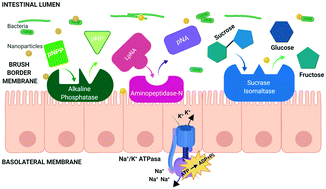The role of metal oxide nanoparticles, Escherichia coli, and Lactobacillus rhamnosus on small intestinal enzyme activity†
Abstract
Engineered nanomaterials (ENMs) have become common in the food industry, which motivates the need to evaluate ENM effects on human health. Gastrointestinal (GI) in vitro models (e.g. Caco-2, Caco-2/HT29-MTX) have been used in nanotoxicology research. However, the human gut environment is composed of both human cells and the gut microbiota. The goal of this study is to increase the complexity of the Caco-2/HT29-MTX in vitro model by co-culturing human cells with the Gram-positive, commensal Lactobacillus rhamnosus or the Gram-negative, opportunistic Escherichia coli; with the hypothesis that the presence of bacteria would ameliorate the effects of exposure to metal oxide nanoparticles (NPs) such as iron oxide (Fe2O3), silicone dioxide (SiO2), titanium dioxide (TiO2), or zinc oxide (ZnO). To understand this relationship, Caco-2/HT29-MTX cell barriers were acutely co-exposed (4 hours) to bacteria and/or NPs (pristine or in vitro digested). The activity of the brush border membrane (BBM) enzymes intestinal alkaline phosphatase (IAP), aminopeptidase-N (APN), sucrase isomaltase (SI) and the basolateral membrane enzyme (BLM) Na+/K+ATPase were assessed. Findings show that (i) the human digestion process alters the physicochemical properties of NPs, (ii) large agglomerates of NPs remain entrapped on the apical side of the intestinal barrier, which (iii) affects the activity of BBM enzymes. Interestingly, some NP effects were attenuated in the presence of either bacterial strain. Confocal microscopy detected bacteria–NP interactions, which may impede the NP-intestinal cell contact. These results highlight the importance of improving in vitro models to closely mimic the complexities of the human body.



 Please wait while we load your content...
Please wait while we load your content...